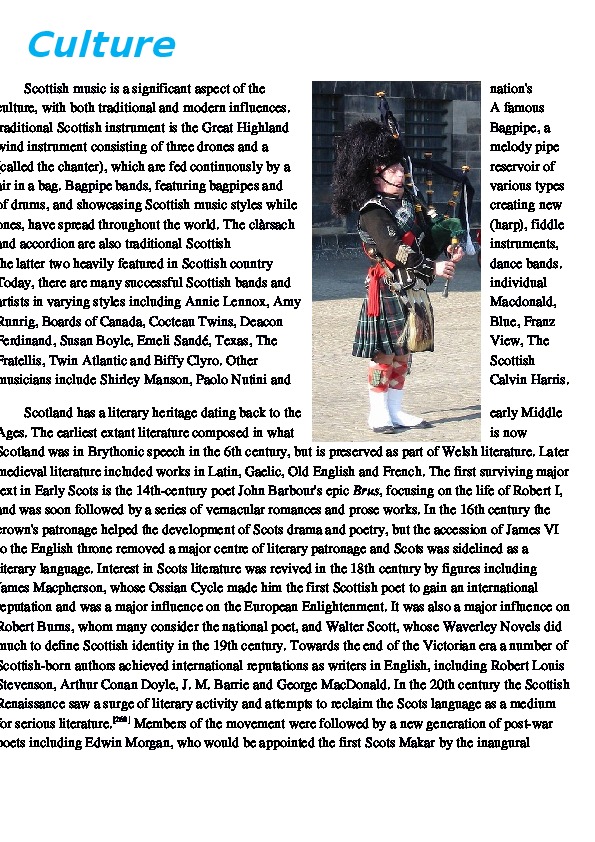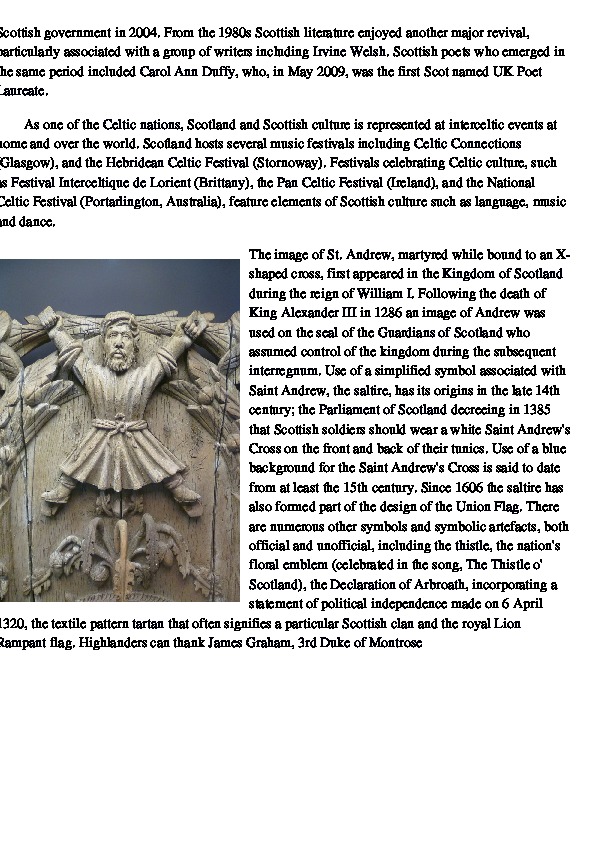Краткое описание документа:
Scottish music is a significant aspect of the nation's culture, with both traditional and modern influences. A famous traditional Scottish instrument is the Great Highland Bagpipe, a wind instrument consisting of three drones and a melody pipe (called the chanter), which are fed continuously by a reservoir of air in a bag.
Culture
Scottish music is a significant aspect of the
culture, with both traditional and modern influences.
traditional Scottish instrument is the Great Highland
wind instrument consisting of three drones and a
(called the chanter), which are fed continuously by a
air in a bag. Bagpipe bands, featuring bagpipes and
of drums, and showcasing Scottish music styles while
ones, have spread throughout the world. The clàrsach
and accordion are also traditional Scottish
the latter two heavily featured in Scottish country
Today, there are many successful Scottish bands and
artists in varying styles including Annie Lennox, Amy
Runrig, Boards of Canada, Cocteau Twins, Deacon
Ferdinand, Susan Boyle, Emeli Sandé, Texas, The
Fratellis, Twin Atlantic and Biffy Clyro. Other
musicians include Shirley Manson, Paolo Nutini and
nation's
A famous
Bagpipe, a
melody pipe
reservoir of
various types
creating new
(harp), fiddle
instruments,
dance bands.
individual
Macdonald,
Blue, Franz
View, The
Scottish
Calvin Harris.
early Middle
is now
Scotland has a literary heritage dating back to the
Ages. The earliest extant literature composed in what
Scotland was in Brythonic speech in the 6th century, but is preserved as part of Welsh literature. Later
medieval literature included works in Latin, Gaelic, Old English and French. The first surviving major
text in Early Scots is the 14thcentury poet John Barbour's epic Brus, focusing on the life of Robert I,
and was soon followed by a series of vernacular romances and prose works. In the 16th century the
crown's patronage helped the development of Scots drama and poetry, but the accession of James VI
to the English throne removed a major centre of literary patronage and Scots was sidelined as a
literary language. Interest in Scots literature was revived in the 18th century by figures including
James Macpherson, whose Ossian Cycle made him the first Scottish poet to gain an international
reputation and was a major influence on the European Enlightenment. It was also a major influence on
Robert Burns, whom many consider the national poet, and Walter Scott, whose Waverley Novels did
much to define Scottish identity in the 19th century. Towards the end of the Victorian era a number of
Scottishborn authors achieved international reputations as writers in English, including Robert Louis
Stevenson, Arthur Conan Doyle, J. M. Barrie and George MacDonald. In the 20th century the Scottish
Renaissance saw a surge of literary activity and attempts to reclaim the Scots language as a medium
for serious literature.[268] Members of the movement were followed by a new generation of postwar
poets including Edwin Morgan, who would be appointed the first Scots Makar by the inauguralScottish government in 2004. From the 1980s Scottish literature enjoyed another major revival,
particularly associated with a group of writers including Irvine Welsh. Scottish poets who emerged in
the same period included Carol Ann Duffy, who, in May 2009, was the first Scot named UK Poet
Laureate.
As one of the Celtic nations, Scotland and Scottish culture is represented at interceltic events at
home and over the world. Scotland hosts several music festivals including Celtic Connections
(Glasgow), and the Hebridean Celtic Festival (Stornoway). Festivals celebrating Celtic culture, such
as Festival Interceltique de Lorient (Brittany), the Pan Celtic Festival (Ireland), and the National
Celtic Festival (Portarlington, Australia), feature elements of Scottish culture such as language, music
and dance.
The image of St. Andrew, martyred while bound to an X
shaped cross, first appeared in the Kingdom of Scotland
during the reign of William I. Following the death of
King Alexander III in 1286 an image of Andrew was
used on the seal of the Guardians of Scotland who
assumed control of the kingdom during the subsequent
interregnum. Use of a simplified symbol associated with
Saint Andrew, the saltire, has its origins in the late 14th
century; the Parliament of Scotland decreeing in 1385
that Scottish soldiers should wear a white Saint Andrew's
Cross on the front and back of their tunics. Use of a blue
background for the Saint Andrew's Cross is said to date
from at least the 15th century. Since 1606 the saltire has
also formed part of the design of the Union Flag. There
are numerous other symbols and symbolic artefacts, both
official and unofficial, including the thistle, the nation's
floral emblem (celebrated in the song, The Thistle o'
Scotland), the Declaration of Arbroath, incorporating a
statement of political independence made on 6 April
1320, the textile pattern tartan that often signifies a particular Scottish clan and the royal Lion
Rampant flag. Highlanders can thank James Graham, 3rd Duke of Montrose


